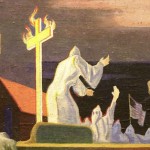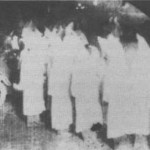The terror-wielding fraternal organization born of white insecurity in the early days of Reconstruction cast a long shadow over more than just the southern states. The Ku Klux Klan, though somewhat quashed by the Civil Rights Act of 1871, experienced a resurgence in the twentieth century due in part to D.W. Griffith’s romantic portrayal of the group in his 1915 film Birth of a Nation . With an endorsement from President Woodrow Wilson, the film contributed to an increase in Klan membership throughout the country. In addition to opposing black advancement, the revived Klan also sought to oppress Jews, Catholics, and immigrants, and to monitor American morality. State and local governments in Texas, Oklahoma, Oregon, and Indiana in the 1920s were largely infiltrated by the Klan. The organization’s influence in Indiana was pervasive among state leaders and the rank-and-file. When self-professed Klansman Edward Jackson was elected governor in 1924, forty percent of all native-born Caucasian men in Indianapolis, along with most members of the City Council, the Board of School Commissioners, and the Board of County Commissioners claimed Klan affiliation.
By the next year, however, the Klan’s clutch on Indiana was seriously undermined by the trial of its central figure, so-called Grand Dragon David Curtiss Stephenson. Stephenson’s conviction in 1925 of the brutal rape and murder of a female state employee laid waste to the Klan’s purported role as a keeper of morality. During his trial Stephenson also revealed his links to Governor Jackson, who was himself charged of attempting to bribe his predecessor. The Indianapolis Times won a Pulitzer Prize in 1928 for its role in uncovering the scandals and breaking up the Klan’s stranglehold on the state.
The Klan never admitted to their involvement in a double lynching on the courthouse lawn in Marion, Indiana in 1930. It is believed that the lynch mob did include former Klan members, although the group had all but collapsed in Indiana by that time. Nonetheless, pockets of Klan activity are said to exist in the state to the present.






















